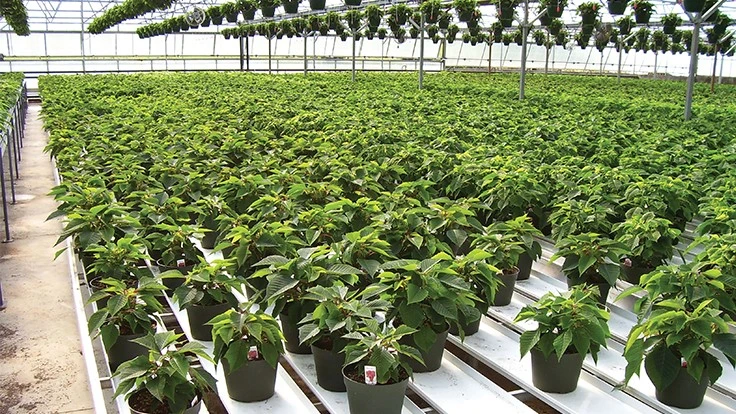

Recirculating irrigation water is a method that can reduce runoff and soil pollution. Instead of letting the leachate drip from the benches or ground beds into the soil, the water is collected, stored and recirculated at the next watering.
Besides the benefit of reducing runoff, there are several other advantages to subirrigation:
- Less labor. Most of the time needed for setup and operation of an irrigation system is eliminated.
- Uniform plant growth. Every plant gets the amount of water it needs.
- Less water is needed. A savings of 50 percent or more can be realized.
- Less fertilizer is needed. Without leaching, fertilizer rates can be reduced 25 to 50 percent.
- Lower humidity. Because the leaves remain dry, there is less evaporation.
- Lower prevalence of diseases. As there is little water movement between containers, the spread of disease is limited.
- Increased space efficiency. Tray and floor systems containers can be spaced more efficiently.
Challenges to ebb and flood irrigation include:
- Greater system cost. Depending on the system, cost can be $10 to $20/square feet of growing area.
- Learning curve. Production techniques are different than conventional production.
- Greater monitoring of irrigation solution. Both EC and pH must be monitored on a regular basis.

System components
In addition to the troughs, benches or flood floors, the basic system contains tanks to collect and hold the water or nutrient solution, pumps and piping to move the water and a control system that regulates when the system is to operate and for how long. Concrete or polyethylene tanks are sized at ½ to 1-gallon capacity/square foot of growing area. Two or more tanks are usually installed to have storage for water and nutrient solutions. PVC pipe and fittings give good service for handling the water or solution. Stainless steel centrifugal pumps are used to handle the nutrient solution and a filter is installed to screen out materials such as growing mix and leaves, timers or a controller are needed to adjust the length of time the pumps operate.
Trough system: This system allows the use of existing benches, therefore reducing cost. PVC or aluminum troughs that are wide enough for the pots to sit in are placed on the benches. Benches are adjusted to provide a slight slope so the water drains from the supply to the discharge end. Water is pumped from the reservoir tank under the benches to the high end of the troughs. A cross gutter at the discharge end collects the water and piping carries it back to the holding tank. Water from the holding tank is then pumped to the reservoir tank, thus the closed system. Trough systems can also be suspended from overhead trusses to gain additional growing space.
Ebb and flood on benches: In this system, the benches remain level and plastic liners are inserted to contain the water. Water from a reservoir is pumped through a two-way valve to the bench. When the level of water reaches ½ inch to 1 inch and the growing media in the containers has absorbed as much as needed, the valve reverses and the remaining water is siphoned out. Partial saturation by restricting the time water is left in the bench can reduce the need for growth regulator chemicals.
Flood floors: Flood floors are becoming popular for growers that produce large numbers of the same-size plants. In this system, there are no aisles and all the area can be used for plants. A concrete contractor with experience in flood floor installation is best as the concrete has to be placed accurately. This makes up about 75 percent of the total cost. Floor heat is installed to provide rapid drying of the floor surface when the water is drained and to provide an ideal root zone temperature. Gutter-connected greenhouses are usually divided into bays at the post lines to provide separate zones to reduce the size of the reservoirs needed. The finished floor slopes about ½ to ¾ inch from the post line to the center of the bay. A supply/drain pipe is installed below floor level and a slot or holes are installed after the floor is finished. The concrete floor along the length of the bay is installed level with a laser screed. Reservoir tanks can be located below the floor in an accessible pit or above ground in an adjacent bay.
Subirrigation systems usually have a payback of three to four years depending on the season of use and the labor saved. In some states, subirrigation systems are eligible for grant funds from USDA NRCS programs. Information about NRCS programs is available here

Explore the March 2019 Issue
Check out more from this issue and find your next story to read.
Latest from Greenhouse Management
- Anthura acquires Bromelia assets from Corn. Bak in Netherlands
- Top 10 stories for National Poinsettia Day
- Langendoen Mechanical hosts open house to showcase new greenhouse build
- Conor Foy joins EHR's national sales team
- Pantone announces its 2026 Color of the Year
- Syngenta granted federal registration for Trefinti nematicide/fungicide in ornamental market
- A legacy of influence
- HILA 2025 video highlights: John Gaydos of Proven Winners





